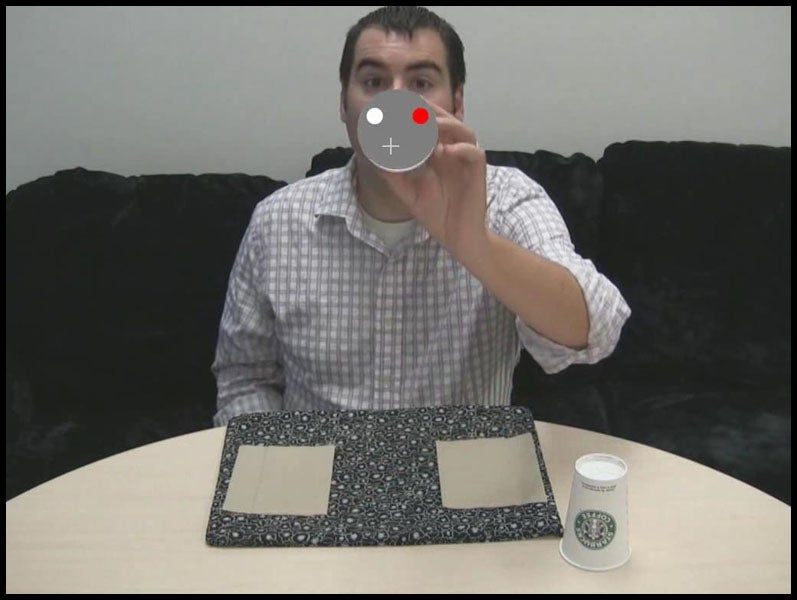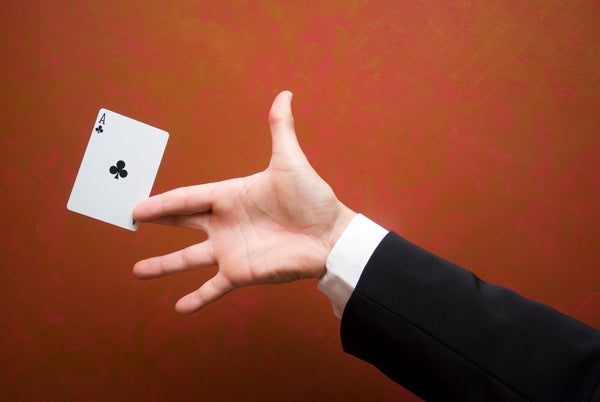This article was published in Scientific American’s former blog network and reflects the views of the author, not necessarily those of Scientific American
When Susana Martinez-Conde and I talk to audiences about NeuroMagic—our research initiative to study the brain with magic (and vice-versa), people often ask us how we bring both fields together. They want to know in what ways magic tricks can inform neuroscience, and what a day in the life of a neuromagic scientist looks like. How do we run a neuromagic experiment, from collecting the data to using the results to gain knowledge about the mind's inner secrets?
Our new study, led by Anthony Barnhart (aka Magic Tony) and just published in the Journal of Eye Movement Research, illustrates some of the ways in which we investigate magic in the lab. You can downloadthe paper for free, but as it is written for academics, I'll give you the gist here.
The experiment addresses how various neural circuits interact in your brain while you watch a magic performance. There's the visual system—critical for perception—there's the oculomotor system—critical for targeting and moving the eyes—and there's the attentional system—critical for filtering out irrelevant information and allowing you to literally and figuratively focus both the visual and oculomotor systems at the right place and at the right time. Without all three of these systems working together, you would be unable to conduct most visual tasks.
On supporting science journalism
If you're enjoying this article, consider supporting our award-winning journalism by subscribing. By purchasing a subscription you are helping to ensure the future of impactful stories about the discoveries and ideas shaping our world today.
Magic is one of the inroads available to dissect the function of many perceptual and cognitive systems, and especially so in situations that are fairly similar to those we encounter in real life. This concept—ecological validity—is important to testing whether neuroscience theories will hold up outside of the lab, and one of the reasons why magic tricks are attractive for studying everyday perception and cognition.
Before I get deeper into our study, there's one important thing you need to know about the oculomotor system: you can never hold your gaze completely still, even though you may feel as if you are able to. That is, whenever you try to keep your eyes from moving, you are nevertheless making tiny eye movements, which are invisible to the naked eye but detectable in the lab. Some of these miniature, involuntary eye motions, take the form of little jumps that occur once or twice per second. They are called microsaccades, and your brain hides them from your perception—a good thing, or you would see the world jumping around all the time. Another critical fact about microsaccades is that your brain controls their direction using the same circuits that control the position of your attentional spotlight in the visual field.
It follows that, when a magician misdirects an audience by controlling their attentional spotlights in precisely choreographed ways, microsaccadic eye movements should change directions accordingly. This means that, by recording spectators’ microsaccades during a magic performance, we may be able to pinpoint their true attentional allocation, even when their eyes are not moving in obvious ways.
The specific experiment we conducted required participants to perform a dual task: determine the position of a coin under one of two napkins, and simultaneously indicate if a flashed stimulus was a match for various items displayed in an array. The movie below shows an example trial, out of many in the experiment:
Magic Tony magically moves a coin while you match the white circle. Credit: Anthony Barnhart
If you correctly matched the white dot to its corresponding location in the array while watching the above video, you may have missed that the coin moved from being under one napkin to the other (the magical method is entirely visible if you look for it). It is extremely difficult to do both tasks well (to match the dot and to see the coin move), so our subjects often guessed on one of the tasks. If you chose to pay attention to the dots, your microsaccades might have been vertically biased, whereas if you paid attention to the napkins instead, your microsaccades might have been biased in the horizontal direction.

Magic Tony and the magical microsaccades. Credit: Anthony Barnhart
Our data showed that microsaccade directions did tend to track those locations that participants paid attention to, supporting the idea that microsaccades may be used to track somebody’s hidden attentional focus in everyday scenarios. Now that you know the story, feel free to give the paper a read for a more in-depth discussion of our results and their implications.
Additional Reading:
Anthony S. Barnhart, Francisco M. Costela, Susana Martinez-Conde, Stephen L. Macknik, and Stephen D. Goldinger (2019). Microsaccades reflect misdirected attention. Journal of Eye Movement Research, 12(6):7
Stephen L. Macknik and Susana Martinez-Conde (2008). Magic and the Brain. Scientific American 299(6): 72-79.
Stephen L. Macknik and Susana Martinez-Conde with Sandra Blakeslee (2010). “Sleights of Mind: What the Neuroscience of Magic Reveals about our Everyday Deceptions,” Henry Holt, New York City.
Susana Martinez-Conde and Stephen L. Macknik (2007). Mind tricks. Nature 448: 414.
Stephen L. Macknik et al. (2008). Attention and Awareness in Stage Magic: Turning Tricks Into Research. Nature Reviews Neuroscience 9(11): 871-879.
